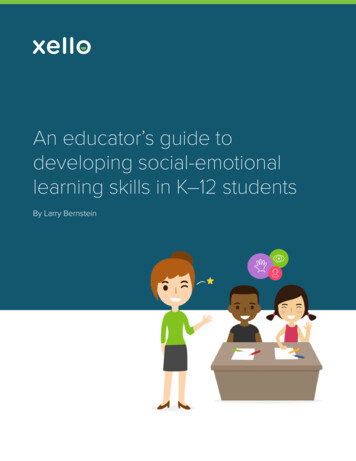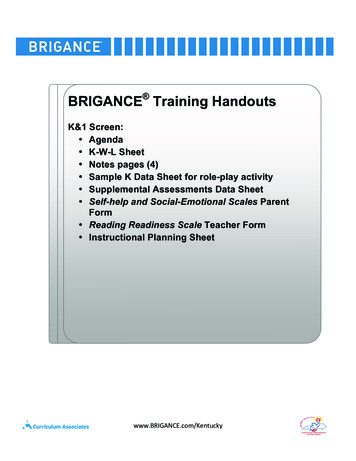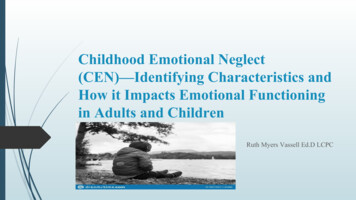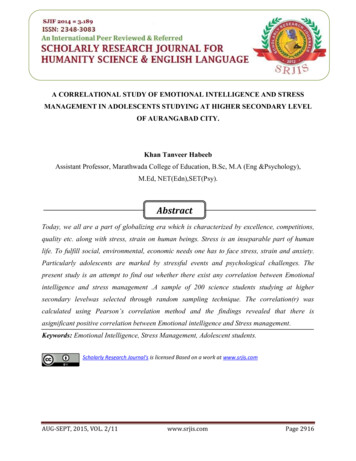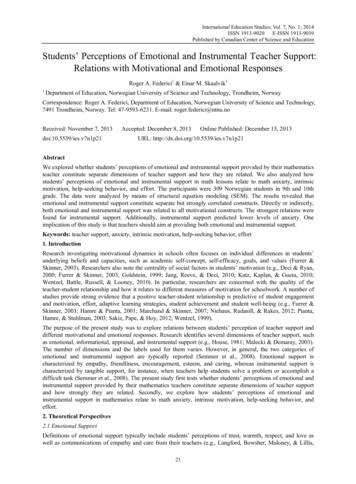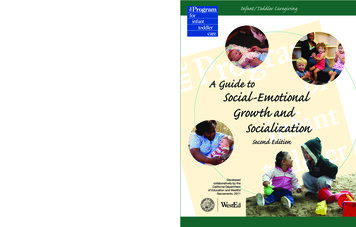
Transcription
Infant/Toddler CaregivingA Guide to Social-Emotional Growth and SocializationCenter type on widthof spine.Do not print thisinstruction.A Guide toSecond EditionSocial-EmotionalGrowth andSocializationSecond EditionSet up barcode in blackink hereISBN 978-0-8011-1711-4ISBN 978-0-8011-1711-4Developedcollaboratively by theCalifornia Departmentof Education and WestEdSacramento, 2011
Infant/Toddler CaregivingA Guide toSocial-EmotionalGrowth andSocializationSecond EditionEdited byJ. Ronald LallyDeveloped byWestEdfor theCalifornia Department of Education
Publishing InformationInfant/Toddler Caregiving: A Guide to Social-Emotional Growth andSocialization (Second Edition) was developed by WestEd, San Francisco.See the Acknowledgments on page vi for the names of those who madesignificant contributions to this documentThis publication was edited by Faye Ong and John McLean, working in cooperation with Peter L. Mangione, WestEd, and Tom Cole, Consultant, ChildDevelopment Division, California Department of Education. It was designedand prepared for printing by the staff of CDE Press, with the cover and interiordesign created and prepared by Cheryl McDonald.It was published by the Department of Education, 1430 N Street, Sacramento,California 95814-5901. It was distributed under the provisions of the LibraryDistribution Act and Government Code Section 11096. First edition 1990. Second edition 2011 by the California Departmentof EducationAll rights reservedISBN 978-0-8011-1711-4Ordering InformationCopies of this publication are available for sale from the California Department of Education. For prices and ordering information, please visit theDepartment Web site at http://www.cde.ca.gov/re/pn or call the CDE Press,Sales Office at 1-800-995-4099. Sacramento, CA 95814; AX (916) 3230823. Mail orders must be accompanied by a check (payable to CaliforniaDepartment of Education), a purchase order, or a credit card number, includingexpiration date (Visa or MasterCard only). Purchase orders without checks areaccepted from governmental agencies only. Telephone orders will be acceptedtoll-free (1-800-995-4099) for credit card purchases only.Photo CreditsPhotographer: Sara Webb-SchmitzFern Tiger Associates (page 26)Special thanks go to the following programs:Associated Students Sacramento State University, Children’s CenterAssociated Students San Francisco State University, Children’s CenterChabot College Children’s CenterContra Costa Community College Early Learning CenterCovina Child Development CenterEben Ezer Family Child CareMarin Head Start, Hamilton CampusMarin Head Start, Indian Valley CampusMarin Head Start, Meadow Park CampusMerced College Child Development CenterSolano Community College Children’s ProgramsWillow Street School HouseNoticeThe guidance in Infant/Toddler Caregiving: A Guide to Social-EmotionalGrowth and Socialization (Second Edition) is not binding on local educationalagencies or other entities. Except for the statutes, regulations, and court decisions that are referenced herein, this handbook is exemplary, and compliancewith it is not mandatory. (See Education Code Section 33308.5)
ContentsA Message from the State Superintendent of Public InstructionAcknowledgments viIntroduction viivSection One: The Developing Self 1Introduction 2Temperaments of Infants and Toddlers 3Stella Chess, M.D.Temperamental Traits and Their Handling 5Three Major Temperamental Patterns 10Chart 1: The Temperament Assessment Scale 13Emotional Development in Infants and Toddlers 14Stanley I. Greenspan, M.D.Stages of Emotional Development 14Emotional Strengths and Their Development 18The Caregiver’s Role 24Chart 2: Baby’s Emotional Milestones 25Chart 3: The Caregiver’s Role in the Child’s Development of Self 28Section Two: The Development of Social Skills 31Introduction 32Creating Nurturing Relationships with Infants and Toddlers 33J. Ronald LallyThe Responsive Process 33Adaptation and Age 37Tips for Getting in Tune 39Self-esteem, Security, and Social Competence: Ten Caregiving Gifts 40Jeree H. PawlTen Caregiving Gifts 40Conclusion 48Section Three: Guidance 49A Developmental Approach to the Socialization, Guidance, and Disciplineof Infants and Toddlers 50J. Ronald LallyPhilosophy and Orientation 50Setting Socialization Goals 54Preventing Behavior Problems 62Individualized Interventions for Disruptive Behavior 65Conclusion 69References 70iii
Section Four: Recent Research on Key Topics 71Introduction 72The Developing Brain and Its Importance to Relationships, Temperament,and Self-regulation 73Ross A. Thompson, Janet E. Thompson, and Julia LuckenbillRelationships and Social Understanding 73Temperament 79Self-regulation 82Conclusion 84References 85Appendix: Social–Emotional Development FoundationsSocial-Emotional Development 88References 114iv87
A Message from the State Superintendentof Public Instructionocial and emotional development in the early years has become widelyrecognized as fundamental to children’s early learning and development inall domains and for later success in school and in life. To address this criticalarea, five noted experts were brought together to create the second edition ofthe Program for Infant/Toddler Care (PITC) Guide to Social-Emotional Growthand Socialization. With a focus on temperament in early development, new researchon early brain development, and the significance of close and secure relationships in theearly years, this publication provides guidance on implementing high-quality early careand education programs.Special attention has been given to the importance of building secure and responsiverelationships with infants and toddlers and their families and of providing developmentally appropriate guidance to foster positive socialization.Above all, this resource offers many practical ideas on how to develop nurturing relationships with children and guide their behavior and learning.The suggestions in this publication complement the research-based descriptions ofsocial and emotional development of typically developing young children that appearin the California Infant/Toddler Learning and Development Foundations. It is our hopethat everyone in the infant/toddler field can use this new publication hand in hand withthe other resources created by the Department to promote the well-being and long-rangedevelopment of California’s youngest children and their families.Tom TorlaksonState Superintendent of Public Instructionv
Acknowledgmentshis publication was developed by the Center for Child and Family Studies,WestEd, under the direction of J. Ronald Lally and Peter L. Mangione. Specialthanks go to Stella Chess, Stanley Greenspan, Jeree Pawl, J. Ronald Lally, RossThompson, Janet Thompson, and Julia Luckenbill for their contributions of sections to this document; and Tom Cole, Consultant, Child Development Division,California Department of Education, for review and recommendations on content.Emily Newton and Kelly Twibell are acknowledged for their thoughtful ideas andcomments on Section Four.Thank you to the following infant/toddler programs for allowing us to take photographs for this publication:Associated Students Sacramento State University, Children’s CenterAssociated Students San Francisco State University, Children’s CenterChabot College Children’s CenterContra Costa Community College Early Learning CenterCovina Child Development CenterEben Ezer Family Child CareMarin Head Start, Hamilton CampusMarin Head Start, Indian Valley CampusMarin Head Start, Meadow Park CampusMerced College Child Development CenterSolano Community College Children’s ProgramsWillow Street School Housevi
Introductionhis document contains awealth of information specifically written to help infantcare teachers or caregiverswith their day-to-day efforts tonurture social and emotional growthin infants and toddlers. This caregiverguide is one of a series developed by theProgram for Infant/Toddler Care (PITC).The California Department of Education,in collaboration with WestEd, createdthe PITC, a research- and practice-basedtrain-the-trainer series to support infantcare programs in providing quality care.The PITC addresses all the major caregiving domains, from providing a safe andhealthy learning environment to establishing responsive relationships with families.This guide to social-emotional development and socialization provides information that pertains to Module I, SocialEmotional Growth and Socialization.The first part of the guide addressesthree areas:1. The Self: The caregiver providesphysical and emotional security foreach child and helps each child toknow, accept, and become confidentin herself or himself.2. Social Skills: The caregiver helpseach child feel accepted in thegroup, assists children in learningto communicate and get along withothers, and encourages feelings ofempathy and mutual respect amongchildren and adults.3. Guidance: The caregiver providesa supportive environment in whichchildren can begin to learn andpractice appropriate and acceptablebehaviors as individuals and as agroup.The guide is divided into four sections.Nationally recognized experts approachthe question of how caregivers can nurture early social and emotional growth.The information provided presents coreconcepts of the PITC that have stood thetest of time. In addition, J. Ronald Lallywrote a new chapter titled “A Developmental Approach to the Socialization,Guidance, and Discipline of Infants andToddlers.” This chapter reflects contentdeveloped for the PITC Module I workshop, “Guidance and Discipline.” Anotherchapter was contributed by Ross Thompson, who summarizes current research onkey topics in the area of early socialemotional development: brain development, attachment relationships, and recentwork on temperament. The two newchapters give up-to-date summaries oftheory and research in the area of socialemotional growth and socialization.Although each chapter focuses on theself, social skills, or guidance, the chapters overlap with one another by design.In daily practice, actions such as helpinga child develop a positive and realisticsense of self, gain self-confidence, learnthe social skills needed to cooperatewith others, or follow social rules are notvii
discrete caregiving functions. They allrequire flexible, individualized care basedon responsive trust-building relationships.Each chapter, therefore, emphasizes andillustrates an attentive, responsive, andnurturing caregiving approach. Similarly,all the writers stress the critical importance of adapting caregiving techniques torapidly changing developmental abilities of children as they move from beingyoung infants, to mobile infants, to oldertoddlers. Thus, for example, J. RonaldLally’s paper shows how the caregiver’srole as a provider and adapter shifts as achild moves from infancy to toddlerhood;Jeree H. Pawl’s gifts become developmentally more sophisticated as childrengrow older; and J. Ronald Lally’s chapteron socialization, guidance, and disciplineexplains how caregivers must choosedifferent rules and limits to emphasize ateach child’s stage of development.The appendix is a reprint of the socialemotional foundations that appear in theCalifornia Infant/ Toddler Learning andDevelopment Foundations (CaliforniaviiiDepartment of Education and WestEd2009). Based on current research, thefoundations describe competenciesinfants and toddlers typically attain frombirth to age three. For each foundation, adescription of competencies is specifiedat three points of development: at aroundeight months of age, at around 18 monthsof age, and at around 36 months of age.In addition, behaviors are listed that leadto the knowledge and skills described foreach of those three age levels.One last point: Although an attemptwas made to make this guide as comprehensive as possible, a decision was madeto handle separately two major topicsessential to the social-emotional development of infants and toddlers. Those topicsare the role of the family and the role ofculture. Because those important topicsmerit in-depth coverage, a guide on eachof those topics is included in the seriesof caregiving guides. Those guides areto be used as companion pieces to thispublication.
Section One:The Developing Self1
Introductionn the first pape , Stella Chess, M.D.,explains how to recognize importanttemperamental differences, traits thatshape a child’s individual style ofbehavior. She defines and illustrates ninecategories of temperament and discussescaregiving approaches best suited to them.Her comments have a direct bearing on thecaregiver’s role in the development of selfand the need for a caregiver’s understanding and flexibility in handling childrenwith different temperaments.Dr. Chess is Professor of Child Psychiatry at New York University MedicalCenter. She coauthored with Mahin Hassibi the textbook, Principles and Practiceof Child Psychiatry. For the past 33 years,she and her husband, Alexander Thomas,have directed the New York LongitudinalStudy, which established the importanceof temperament in child development.In their work Behavioral Individualityin Early Childhood, Temperament andBehavior Disorders in Children, theyreported the findings of their longitudinalstudy. This research significantly alteredthe study of normal child development andchild psychiatry.In the next paper, Stanley I. Greenspan,M.D., offers a picture of healthy emotional2growth during a child’s first three years.He charts for caregivers six differentstages of emotional development, andhe looks at the kinds of early experiencenecessary to nourish this development. Inhis paper he demonstrates the importanceof providing physically and emotionallysecure environments and underscores therole of caregiver as a model for the development of social skills.Dr. Greenspan is Clinical Professor ofPsychiatry and Behavioral Science and ofChild Health and Development at GeorgeWashington University Medical School,Washington, D.C., and he is on theacademic faculty of Children’s HospitalNational Medical Center in Washington,D.C. He is the author of Intelligenceand Adaptation; Psychopathology andAdaptation in Infancy and Early Childhood; The Clinical Interview of the Child:Theory and Practice; coauthor withNancy T. Greenspan of First Feelings:Milestones in the Emotional Developmentof Your Baby and Child; and editor of Infants in Multirisk Families: Case Studiesin Preventive Intervention. Dr. Greenspanis also a practicing child psychiatrist andpsychoanalyst.
Temperaments of Infants and ToddlersStella Chess, M.D.ight from the start, babies aredifferent. Each has his or herown way of showing feelingsand of responding to theworld around him or her.These differences, clearly visible in thefirst few months of life, are expressed inmany ways. They can be uncovered by acaregiver who discovers: how active the infant is in bodymovements; how regular or irregular he is insleeping, feeding, and having bowelmovements; how easily the infant accepts a newfood, person, or place; how long it takes the infant toadjust to a change in her scheduleor surroundings; whether the infant’s mood is mainlycheerful, neutral, or fussy; how sensitive he is to loud noises,bright lights, rough clothing, a wetor soiled diaper; whether or not the infant can beeasily distracted from the activityshe is engrossed in; how long the infant persists ingiving his attention to any singleactivity.are crucial to nurturing children’s healthyemotional growth. For example, you maydiscover: that certain children’s “headstrong,”seemingly cantankerous behaviorstems from their temperamentalslowness in adapting to new places,people, or games; that some toddlers are grumpy a lotand fly o f the handle easily becausethey are unusually sensitive to loudnoises and small discomforts.A better understanding of how temperament works, especially when an infant’sor toddler’s behavior is exasperating, canhelp us maintain our own patience andpositive attitudes as caregivers. It can alsolead us to find the best ways to deal withsuch behavior. It is important to adjustSuch traits make up a child’s individualstyle of behaving—his or her temperament. Being alert to these temperamentaldifferences and understanding how theyrequire different caregiving approaches3
our responses to fit a particular child stemperament. A caregiving approach thatworks well with an outgoing, highly expressive child may be less effective, evenharmful, with a placid or shy child.The purpose of this paper is to helpyou recognize such temperamental differences in very young children so thatyou can develop effective ways of relatingto children through their temperament.Based on many years of careful research,my husband, Alexander Thomas, and Ifound that the behavior of infants andtoddlers can be defined according to ninecategories of temperament, which areidentified on the pages that follo .*Before outlining the nine categories oftemperament, I need to emphasize a fewgeneral points about temperament and itshandling:*No one made a full systematic study of these temperamental traits or their influence on the child s psychological development until my husband, Alexander Thomas,and I undertook a project starting in 1956. We started bygathering and analyzing details of the behavior of 133infants averaging two to three months of age. (We havecontinued to follow these youngsters and are conducting a new follow-up into their behavior and lifestyles,now that they are adults.) In the research project, widelyknown among professionals as the New York Longitudinal Study, we found that the young infant’s behaviorcould be defined and rated according to nine categoriesof temperament. Some aspects of temperament can beidentified in the newborn, but in general they only beginto be clearly evident by two to three months and verydefinite by the end of the first ye . Some young childrenshow remarkable consistency in temperament from oneyear to another. Others show less consistency, probablybecause of the way they are handled by their caregiversand perhaps by differences in rate of brain development,just as normal children vary in the time and way in whichthey begin to walk or talk. Several research studies haveshown a genetic factor in temperament; other biologicalfactors, as yet unknown, are undoubtedly involved inshaping the newborn’s temperament. There is no evidencethat the parents’ handling is the cause of the child’s temperament. However, the manner in which the parents orother caregivers respond to the child’s temperament maymodify, or even change, its expression. Our findings ofthese nine categories of temperament and their importance for caregiving have been confirmed in recent yearsin different social classes and cultures by a large numberof studies from several research centers in this country, aswell as from various European and African countries andJapan, India, and Taiwan.4 Differences in temperament, even atthe extremes, are differences withinthe normal range of behavior. All toooften a child whose behavior is different from the average is labeled bycaregivers and even by mental healthprofessionals as having a behaviorproblem when, actually, the child isshowing only his or her normal temperament. For example, some children are temperamentally inclined tomove around a lot. This is a normaltrait, not the pathological type ofmovement called hyperactivity. Thekey is to try to understand how thatparticular trait influences the child sbehavior and to find the best ways ofhandling it. When caring for a child whose highor low extremes of temperament aretroublesome, your goal should not beto insulate and protect the child fromthose situations that are distressing.That will only restrict the child’s lifeand deny the child valuable oppor-
tunities of learning to master socialexpectations as other children do.Without such experiences childrenwill not develop a basic sense of confldence and self-worth, which comefrom the proof in actual life that theyare capable of coping successfullywith the behavioral demands thattheir world expects of them. Rather,the approach to such a youngsterinvolves flnding what we call a”goodness of flt‘ between caregiverand child. There is a goodness of fltwhen you handle the child and makedemands in a manner that enables thechild to meet the demands successfully. When that happens, the child sdevelopment can proceed in a healthydirection. If, however, you pressurethe child for a quickness and levelof adjustment that is beyond theyoungster s temperamental abilityto achieve, there is a ”poorness offlt,‘ with the likelihood that a realbehavior problem could develop. Do not blame the child if he or sheis showing troublesome behaviorbecause of a temperamental trait.The child is not being troublesomedeliberately (to be malicious orspiteful). Also, do not blame theparents. They may not understandtheir child s temperament and may,in all good faith, be applying childrearing rules that do not flt theirparticular child s temperament.Temperamental Traits and Their HandlingIn describing the nine different traits, I will emphasize the extremes in each case“ forexample, high levels of energy or sensitivity versus low levels“because children withthese traits are the ones most likely to need special attention or handling. I will give typical examples of how very young children express such traits, and I will suggest the bestcaregiving approaches to take.The majority of children display temperament at a level somewhere in between theextremes of temperament, and these children will flt into home or child care routinesfairly easily. In this sense, temperament is similar to intelligence; that is, children of low,average, or very high intelligence may require special attention, and those of average orslightly superior intelligence will adapt to the routine school curriculum without greatdifflculty. I will also look at how these speciflc traits often combine in a child s overallmakeup to form certain major patterns of behavior.1Activity Level: Amount of movement and bodily activityHigh ActivityThe child who is highly active prefers gamesand play with a lot of movement; kicks andsplashes in the bath, and likes to run around.Gets restless and distressed if made to sitquietly in one spot for long periods. Give achild with this level of activity opportunitiesfor active play. If the group is engaged insome quiet activity, let this type of childmove around from time to time.Low ActivityThe child with low activity prefers quietgames and can sit calmly, looking at picturebooks or coloring, for long periods of time.Because this child moves slowly, he or sheis sometimes teased as a slowpoke. Youshould expect that it will take a child withthis level of activity extra time to get thingsdone, such as dressing or moving from oneplace to another.5
2Biological Rhythms: Regularity or irregularity of such functions as sleep-wakecycle, hunger, and bowel eliminationRegularityThe regular child sleeps through the night,takes a regular nap, eats about the sameamount from day to day, and has a bowelmovement about the same time each day.This child presents no problems withfeeding or sleeping schedules and is usuallytoilet trained easily.3Approach/Withdrawal: How the child responds to a new situation or other stimulusApproachThe approacher responds positively to anew food by swallowing it, reaches for anew toy, smiles at strangers, and when firstjoining a play group, plunges right in. Such achild presents few problems to the caregiver,except when this responsiveness is combinedwith a high level of activity. Then the approacher may run impulsively to climb anew rock or jungle gym, which he or shecannot really manage, or he or she may tryto explore a potentially dangerous object.6IrregularityIn contrast to the regular child, this onevaries in sleep habits and hunger patterns,and he may wake up several times at night.The irregular child’s big meal may be lunchone day and dinner the next, and her bowelmovements are unpredictable. You shouldaccept this child’s irregular nap and feedingschedules. The child can be trained to sleepthrough the night if not picked up every timeshe cries. Toilet training will usually takelonger and may not succeed until the childlearns to be consciously aware of the internalsensation that signals a bowel movement.WithdrawTypically cautious about exploring new objects, the withdrawer is likely to push awaya new toy or to spit out new food the firstfew times. Around strangers or when firsttaken to a new place, this child may fuss orcry and strain to get away. You should bepatient with these initial negative reactions.Pressuring the child to make an immediatepositive adjustment only increases his or herdiscomfort and makes it harder for the childto accept new people and things. Instead,small and repeated exposures to the unfamiliar let the child gradually overcome hisor her early reluctance.
4Adaptability: How quickly or slowly the child adapts to a change in routineor overcomes an initial negative responseHigh AdaptabilityThe quickly adaptive child adjusts easilyto the family’s move to a new home or avisit to a strange place. After only a fewtrials, this child accepts new food that wasfirst rejected and is agreeable to changes inmealtimes and sleeping schedules. Such achild does not usually present problems to acaregiver. Occasionally the youngster maygive in too early to unreasonable requestsfor change, such as a playmate changingthe rules in the middle of a game. Thequickly adaptive child may benefit fromencouragement to “stick to your guns.”5Low AdaptabilityBy contrast, the slowly adaptive child takesa long time to adapt to change or to acceptsomething new that he or she originally rejected. Such a child is sometimes misjudgedas stubborn or willfully uncooperative.A more accurate term would be cautious.Your approach should be the same as forthe withdrawing child—being patient, giving the child a number of exposures to thechange, and encouraging the child when heor she begins to show signs of adjusting.Pressure to make such a child adapt veryquickly will only boomerang and have theopposite effect.Quality of Mood: The amount of pleasant, cheerful, and openly friendlybehavior (positive mood) as contrasted with fussing, crying, and openlyshowing unfriendliness (negative mood)Positive MoodSmiling and laughing often, the child whosemood is positive is easily pleased and showsit openly. Fussing and crying are infrequent.This positive mood usually causes positiveresponses in adults, who find it easy to carefor such children.Negative MoodThe child whose mood is negative tendsto fuss or complain a lot, even at trivialdiscomforts, and cry before going to sleep.This child may show little or no openexpression of pleasure, even at games orother events that please, but rather willhave a deadpan expression. Be sure to spotsuch a child. While not ignoring the child’sfussing or complaining, respond cheerfullyto him or her. You may find to your surprisethat although the child gives no outwardevidence of pleasure at some special event,such as an expedition to the zoo, the childlater reports it to his parents or friends as anexciting, happy event.7
6Intensity of Reactions: The energy level of mood expression, whether it ispositive or negativeLow IntensityThe low-intensity child expresses bothpleasure and discomfort in a low-key way.If happy, this child may smile or say quietlythat he is pleased; if upset, the child maywhine a little or fuss, but not loudly, or maysay quietly that he is unhappy. It is easy tomisjudge and miss what is going on insidethe child if you take the mild reactions asevidence that he is not really displeased orupset. Remember that mild expressions maymask strong emotions. Pay careful attentionto such expressions and take seriously thefeelings behind them.7Sensitivity Threshold: How sensitive the child is to potentially irritating stimuliLow ThresholdThe child with a low threshold may beeasily upset by loud noises, bright lights, awet or soiled diaper, or sudden changes intemperature. This child may not be able totolerate tight socks or clothing with a roughtexture. You should be aware of and attendto those reactions but not try to changethem.8High IntensityBy contrast, the high-intensity child expresses his feelings with great intensity.When happy, this child bubbles and laughs;when upset she cries loudly and may evenhave a tantrum. In this case you have anopposite task: to evaluate objectivelywhether the issue is important or trivial andnot be guided only by the intense reactionsof the child.High ThresholdThe child with a high threshold is not bothered by the same kind of stimuli as the childwith a low threshold is. You should checkregularly to see if the infant has a wet orsoiled diaper to avoid diaper rash. Otherwise, this child may be content to suffer thediaper irritation because this child’s highthreshold keeps him from feeling irritatedand uncomfortable.
8Distractibility: How easily the child can be distracted from an activity like feedingor playing by some unexpected stimulus—the ringing of a telephone or someoneentering the roomHigh DistractibilityThe highly distractible child may startand look up at the sound of a door closing softly. As one parent put it, half thesolid-food feeding went into the child’s earbecause she constantly turned her head atsmall noises or glimpses of movement. Inthe early childhood period, the tendencycan be an asset to the caregiver. The childwho is fussing at being dressed or is pokingat an electric outlet can be easily distractedby showing her a toy or other attractiveobject. In older childhood, however, whenpersistent concentration on a task such ashomework is welcomed, high distractibilitymay not be such a desirable trait.9Low DistractibilityThe child who is not easily distracted tendsto stick to an activity despite other noises,conversations, and people around. This isdesirable
the Program for Infant/Toddler Care (PITC) Guide to Social-Emotional Growth and Socialization. With a focus on temperament in early development, new research on early brain development, and the significance of close and secure relationships in the early years, this publication provides guidance on implementing high-quality early care

